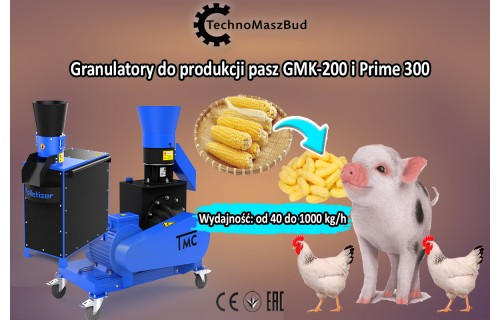Granulatory do pasz firmy TECHNOMASZBUD. Jakie problemy pozwalają rozwiązać?

Na początek zdefiniujmy sam termin „granulator”. Jest to urządzenie, które zamienia surowce sypkie (mieszanki paszowe, słomę, zboże, odpady warzywne) w granulat.
Pierwszy granulator
wyprodukowano w USA w 1911 roku, natomiast początek granulacji pasz datuje się
na lata trzydzieste ubiegłego wieku. To wówczas rozpoczęto na większą skalę
badania nad technologią wytwarzania pasz w formie granulatu i ich zastosowaniem
w żywieniu zwierząt.
Na granulatory zaczęli zwracać uwagę rolnicy i hodowcy w takich krajach jak Anglia, Dania, Holandia i Niemcy. Za pomocą tego sprzętu mogli stworzyć granulat paszy, który zwierzę musiało zjadać w całości, nie wybierając ulubionych składników, a tym samym pozyskując z niej wszystkie niezbędne wartości odżywcze.
Istotnymi zaletami procesu granulacji są łatwiejsze przechowywanie i transport pasz oraz możliwość produkcji granulatu nie tylko dla zwierząt, ale również dla drobiu. Po przetworzeniu składniki nie tracą swoich wartości odżywczych, lecz wręcz przeciwnie stają się lepsze. W szczegółach wygląda to tak:
ZAGŁĘBMY SIĘ W PROCES GRANULACJI: CO SIĘ DZIEJE Z SYPKĄ KARMĄ?
Na etapie prasowania sypki materiał poddawany jest działaniu wysokich temperatur i silnemu prasowaniu, wskutek czego złożone substancje chemiczne rozkładają się na bardziej proste. Na przykład skrobia rozpada się na cukry proste, które lepiej i szybciej się przyswajają. Oprócz tych zalet można również zauważyć, że mieszanka przechodzi etap odkażania, usuwane są drobnoustroje chorobotwórcze, które wywołują infekcję jelitową.
Po załadowaniu do zasobnika mieszanka jest równomiernie podawana do części roboczej granulatora za pomocą podajnika, a mianowicie na matrycę z rolkami. Następnie sprasowana mieszanka wychodzi przez kanały przelotowe (otwory). Długość granulatu jest kontrolowana przez specjalny nóż obcinający zainstalowany w granulatorze, a średnica – dzięki różnym otworom w matrycy. Specjaliści z firmy Technomaszbud Sp. z o.o. dobierają matrycę według indywidualnych potrzeb z uwzględnieniem tego, co klient chce produkować.
DLACZEGO BARDZIEJ SIĘ OPŁACA ZAKUP GRANULATORA, NIŻ ZAKUP GRANULOWANEJ PASZY?
Pasze wyprodukowane z zastosowaniem granulatorów Technomaszbud mają dodatkowe zalety w porównaniu do pasz sypkich:
- dłuższy termin przechowywania ze względu na niszczenie grzybów i drobnoustrojów chorobotwórczych w procesie termicznym produkcji
- wyższą odporność na wilgoć
- mniejsze straty w transporcie i przy załadunku oraz rozładunku
- możliwość produkcji w zależności od potrzeb
Do wyprodukowania 1 tony paszy w formie granulatu dla kur niosek potrzeba 400 kg pszenicy, 400 kg kukurydzy, 150 kg śruty sojowej i 50 kg dodatku mineralno-witaminowanego. Koszt wszystkich składników wynosi obecnie ok. 1300 zł/tonę. Zakładając cenę gotowej paszy dla kur niosek na poziomie 2140 zł/tonę (za PASZE-24.PL) otrzymujemy korzyść ok. 840 zł na tonie paszy przy produkcji własnej. W przypadku „małej” fermy liczącej 20 tys. kur i założeniu, że kura dziennie zjada średnio 150 g paszy, roczne zapotrzebowanie na paszę wynosi ok. 1100 ton. Przy takiej ilości sumaryczna korzyść wynosi ok. 900 tys. zł w skali roku. Ta wartość pozwala z nadmiarem pokryć koszty energii elektrycznej i operatora maszyny. Jeżeli ceny surowców (pszenicy, kukurydzy, śruty sojowej) będą niższe, to produkcja będzie jeszcze bardziej opłacalna, ponieważ ceny gotowych pasz granulowanych z reguły nie spadają proporcjonalnie.
Do wyprodukowania 1100 ton paszy w formie granulatu dedykujemy granulator serii PRIME, model 300.
ZALETY I CECHY GRANULATORÓW SERII KGM/GMK/PRIME FIRMY TECHNOMASZBUD
|
Wymiary / Model |
KGM-100 |
GMK-200 |
GMK-260 |
PRIME-300 |
|
Długość |
610 mm |
900 mm |
900 mm |
1300 mm |
|
Szerokość |
420 mm |
700 mm |
700 mm |
900 mm |
|
Wysokość |
420 mm |
1400 mm |
1500 mm |
1300 mm |
|
Waga |
45 kg |
160 kg |
250 kg |
650 kg |
|
Główne cechy |
||||
|
Średnica otworów w matrycy |
od 2 do 6 mm |
od 2 do 8 mm |
od 2 do 8 mm |
od 2 do 8 mm |
|
Zastosowanie |
do produkcji granulowanych pasz |
|||
|
Typ towaru |
granulator |
granulator |
granulator |
granulator |
|
Rodzaj napędu |
elektryczny |
elektryczny |
elektryczny |
elektryczny |
|
Wydajność |
do 40 kg |
do 200 kg/h |
do 300 kg/h |
700 kg/h |
|
Moc silnika |
1.5 kW |
7.5 kW |
11 kW |
30 kW |
|
Napięcie |
220V/380 V |
380 V |
380 V |
380 V |
|
Prędkość obrotowa rolek /min |
250 obr. |
250 obr. |
250 obr. |
215 obr. |
|
Średnica matrycy |
100 mm |
205 mm |
259 mm |
300 mm |
|
Dodatkowe cechy |
||||
|
Okres gwarancji |
12 m-cy |
12 m-cy |
12 m-cy |
12 m-cy |
|
Ilość walców |
2 szt. |
2 szt. |
2 szt. |
2 szt. |
|
Ilość noży |
1 szt. |
1 szt. |
1 szt. |
2 szt. |

